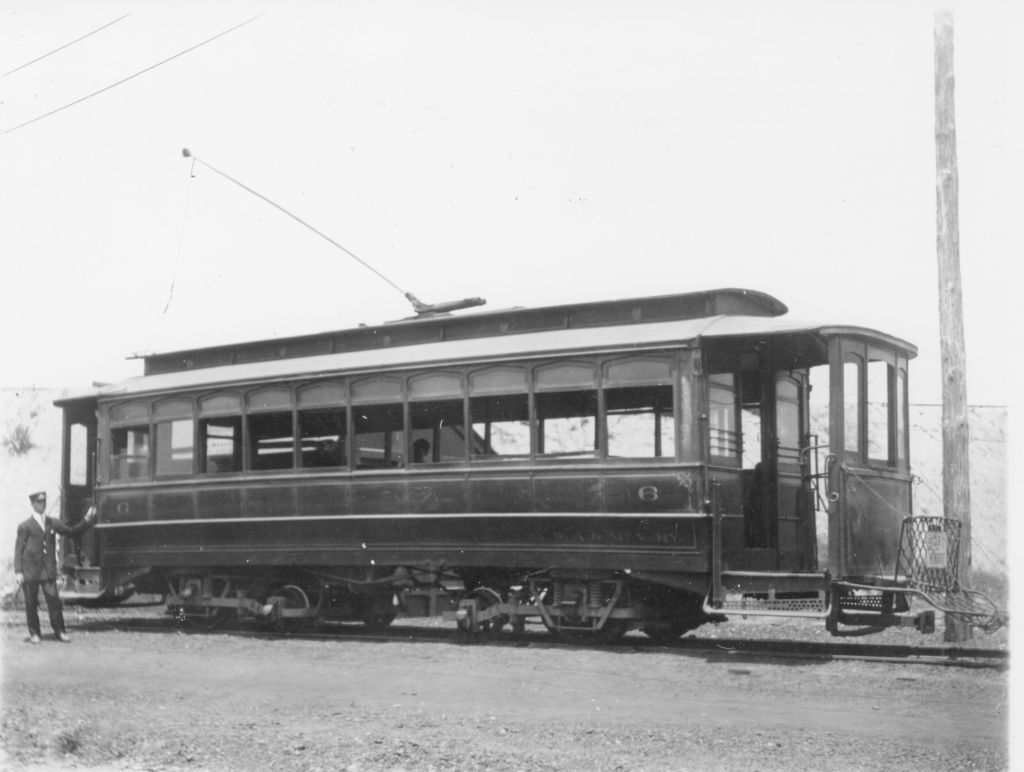The (Electric) Railroad Comes to Town

Into the 1970s the mouth of Four Mile Run was a shallow tidal pool. The electric railway build a berm across it and here we see one of their cars making their way across, probably in the 1920s.
A flaw in the conceptualization of the early suburbs was the lack of transportation. In the era before automobiles maintaining a horse and carriage was an ongoing expense, and one that left the household isolated once the breadwinner had taken it to work. Steam railroads preferred cruising rather than a stop-and-go mode and only the wealthy could afford the fares the railroads charged for such service, as along the famous main line suburbs of Philadelphia.
This would change with the development of electric streetcar traction. Initially used only for urban routes, visionaries began wondering if they could be used to expand a city's reach. Ironically, the coming of the streetcar to northern Virginia was not the result of any desire to incorporate the suburbs into DC or Alexandria, but as a tourist venture.
Mt Vernon had become a tourist draw by the 1880s but there was no convenient overland way to get there from DC. Early plans looked at building a grand “Mount Vernon Avenue” from the district to the historic site, but this was not appealing before the motor car came about. Instead the Washington, Alexandria and Mount Vernon Electric Railway was chartered in 1890 to run a line to the south. The first portion, between Alexandria and Mount Vernon quickly proved profitable and in November 1894 a spur track carried passengers from Alexandria north to the race track in what would become Del Ray.

The company was quick to recognize its potential for commuter traffic. There was public sentiment, including lobbying from the race track owners, to run the track on the shortest route from Alexandria to DC, parallel to the main steam line tracks, but the company resisted and actually laid them to the west, passing through the new developments of Spring Park (later Rosemont), North West Alexandria and Park Addition. Planning for this route was carried out in 1894, although the by the time they bought the rights-of-way, got legislation through Congress allowing them to use the eastern portion of Arlington Cemetery Reservation, and laying the tracks, the first trains did not run until mid-1896.
Nevertheless, the plans and momentum were enough to persuade the Wood Harmon Company based in New York City to purchase adjacent land for two new developments, Del Ray and St Elmo, in 1894.
When the rail line, a single track until 1905-07, was laid down it ran along what is now Commonwealth Avenue from Union Station on King Street to Four Mile Run, then across on a berm into Arlington. The “stations” were simple three-sided wooden sheds, similar to bus shelters. They were thus simple to build and could even be moved as needed.
Car No.6 was one of the early ones having been built by Brill in 1892. It is seen here after some modernization around 1900 by the railway shops. (Ames Williams Coll)

Rosemont had a substantial station, but those in the Del Ray area were basic, as the Mt Ida station in 1918 shows (courtesy Buddy Johnson)
The original station setup in the area between King Street and Four Mile Run included only four stops through 1900: Braddock (at Alexandria Ave to serve the Park Addition and NW Alexandria developments), Del Ray (at Peyton, now Del Ray, Ave), St Asaph (where it crossed Mt. Vernon, to serve the racetrack), and St Elmo (where it passed under the W&OD tracks). Later stations were added as development expanded: Spring Park (at Rosemont Ave), Braddock North (at Monroe Ave), and Mt Ida (at Mt Ida Ave).
Within a few years the commuter business had completely overtaken the tourist passenger load to Mt Vernon, eclipsing the railway's original raison d'etre. By 1920 The Del Ray area was served by 33 northbound trains to DC, starting 6.03 AM and finishing at 12.43 AM. The return scheduling being about the same, it was practical to live in the suburbs and commute to work in DC.
The availability of inexpensive automobiles doomed the suburban streetcar systems. By the mid-1920s the line now known as the Washington-Virginia Railway was losing money and in 1927 was sold under foreclosure. Most of the operations gradually shut down, but the Alexandria-Washington leg was purchased in March 1930 and actually managed to show a profit as a high-density, short-haul trolley.

While Virginians rose to the defense of their beleaguered lines, the District had other plans for the northern terminus and closed off access to the city. Finally the railroad was forced to cease operations into DC, instead shuttling their passengers by bus from Arlington Junction, near the current site of the Pentagon. This proved inconvenient and in April 1932 the company ceased operations after 40 years. The roadbed south of Alexandria was taken over by the National Park Service for the George Washington Parkway, while the portion from King Street to Four Mile Run was turned into Commonwealth Avenue, the twin-track arrangement and access roads leading to a wide boulevard with center islands.
Interurban streetcars, running from one town or city to another, did not prove long-lived. Nevertheless, the streetcar suburbs, of which the Del Ray area was a pioneer, were a fascinating transition between the urban cores of the city and today's auto-centric suburbs.
Car No.303, one of the later models purchased specifically for the commuter trade. It could not, however, save the railway.